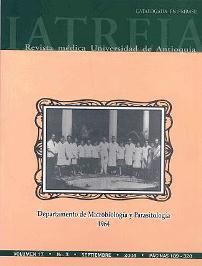Why is thalidomide back?
DOI:
https://doi.org/10.17533/udea.iatreia.4067Keywords:
Thalidomide, Teratogenesis, Antiangiogenesis, ImmunomodulationAbstract
Background: in 1998 the FDA approved the restricted commercialization of Thalidomide for the treatment of Erithema Nodosum Leprosum. Brazil and Mexico have also regulated its use. Because of the current use of this teratogenic drug in rheumatological, dermatological, infectious and neoplasic diseases, it is necessary to instruct General Practitioners and specialists on its most relevant topics, active principle, benefic and deleterious effects.
Materials and Methods
We carried out a revision by reading and analyzing controlled clinical trials, randomized or not, case series and reviews about thalidomide and its potential uses, that appeared in Medline from January 1993 to December 2003, to draw indications and contraindications in light of the evidence found in them.
Results
forty six randomized controlled studies were found and 22 (with at least 50 patients described) were reviewed (complete articles and/or including design and end points measured – expressed abstracts), plus 10 reviews and 22 cases series. The analysis allowed us to inform potential or restricted and not indicated uses of thalidomide in humans, its pharmacokynetic principles which explain its benefic and deleterious effects, and recommendations to prevent teratogenesis.
Conclusion
thalidomide is available, with restrictions, for the treatment of Erithema Nodosum Leprosum (first line) and Multiple Myeloma (refractory to multiple chemotherapy). It appears to have beneficial effects in many other serious conditions refractory to first line treatments: AIDS, esophagus and prostate cancer and some severe dermatosis, rheumatological or not.
Downloads
Downloads
Published
How to Cite
Issue
Section
License
Papers published in the journal are available for use under the Creative Commons license, specifically Attribution-NonCommercial-ShareAlike 4.0 International.
The papers must be unpublished and sent exclusively to the Journal Iatreia; the author uploading the contribution is required to submit two fully completed formats: article submission and authorship responsibility.














